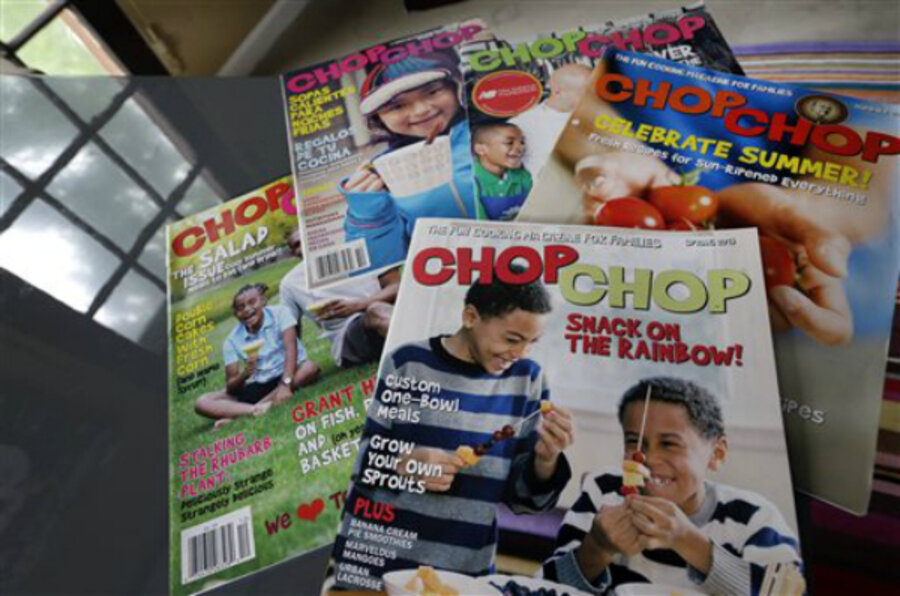Childhood obesity: ChopChop mag says forget lectures, teach kids to cook
Loading...
For years, cookbook writer Sally Sampson had wanted to write for children. No one was interested.
But by 2010, the time was right. Alarm over rising rates of childhood obesity was reaching new heights, as was awareness of the importance of cooking and eating real foods, not just for children, but for whole families and communities. Sampson seized the moment, launching ChopChop, a cooking magazine for children.
And in the three years since, she has transformed a simple idea – that getting children cooking is good for them – into an award-winning quarterly that reaches some 2 million families.
The concept is straightforward – the magazine portrays real children eating real food that they can cook themselves with little or no help from an adult. The recipes are nutritious, ethnically diverse and inexpensive. Most of its circulation comes from free distribution by doctors during well-child visits. It also is available by subscription, and in Spanish.
"We think about kids as beginner cooks," Sampson says, noting that her target audience is 5- to 12-year-olds. "We don't do 'kids' food.' We do simple dishes. If you had a 20-year-old who didn't know how to cook, you'd teach them the same thing."
The idea is that children who know how to cook and feed themselves will not have to rely on fast food and processed meals. And that families who cook and eat together have healthier lifestyles overall.
Since its launch, ChopChop – which is based in Watertown, Mass. – has become an industry darling. Its board of directors is stacked with renowned physicians. The magazine relies on sponsorship, not advertisements, and receives its largest chunk of funding from footwear company New Balance, which has given more than $1 million. And, in May, the James Beard Foundation named ChopChop "publication of the year."
And this year, Sampson returns to her cookbook roots. Sporting more than 100 recipes, "ChopChop: The Kids' Guide to Cooking Real Food with Your Family," will be published in August by Simon and Schuster.
"This is like a magnet for kids," says Barry Zuckerman, professor of pediatrics at Boston University School of Medicine and a member of Sampson's board of directors. Zuckerman says that 20 years ago he saw maybe two obese children a week in his practice. Today, he sees two to four a day. A founder of Reach Out and Read, a 24-year-old program that promotes literacy by giving books to children during doctor's visits, Zuckerman responded immediately to Sampson's model.
"Advice is cheap," he says. "Giving a one- or two-minute lecture about healthy foods is nice, but when we give ChopChop it really amplifies the message in a way that words just don't."
Nothing in Sampson's public background would suggest that she was a nut for children's health. Many of her cookbooks tackled single subjects, including party dips, ice cream, cookies and burgers. But her views had been formed while tending to her daughter, who was ill through much of childhood. (Her daughter, now 20, is fine, Sampson says.)
Her "ah-ha" moment came seven years ago, when she read a newspaper article by Harvard pediatrician and medical school professor Donald Berwick that took the nation's medical system to task.
"It was like I was reading for the first time about somebody who cared about what I cared about," Sampson said. "I wrote an e-mail to him and said, 'If I could work for you I would never write another cookbook again.'"
Berwick wrote back. After dabbling in various health-related work, Sampson began approaching pediatricians with an idea to prescribe cooking during appointments. The enthusiasm was fierce and immediate, she says. She received more than 140 requests from pediatricians for the as-yet unborn magazine. She began raising money, collecting enough from companies such as Stonyfield Farm, Oxo, and children's hospitals to print 150,000 copies of her first issue. She parked her car on the street and kept 8,000 copies in her garage.
After that first issue, Sampson says, requests poured in from afterschool programs, YMCAs, Boys and Girls Clubs of America, Indian reservations, food banks, neighborhood health clinics, and other organizations. New Balance came on board as the main sponsor and remains the biggest donor.
"We were really excited about being part of a movement to get kids cooking again," says Molly Santry, the company's charitable programs manager. "We had funded hands-on cooking classes and the magazine was another resource for kids and families to get inspired to cook."
Sure, Sampson would like to see every family in America cooking together or to have obesity eradicated by 2020. But her immediate goals are more straightforward: she wants "to make cooking cool" and to give children the skills to stay healthy throughout their lives. With the editorial machine in motion, she says only one obstacle remains.
"Money," she says definitively. "The demand for ChopChop is huge. We are only slowed down by money. The more money we get, the more people we can reach."







